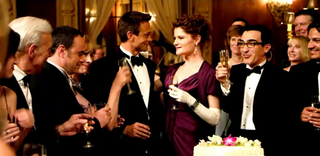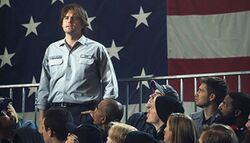Atlas Shrugged (film)
Atlas Shrugged was a series of three movies based on Ayn Rand's large 1957 doorstop by the same name. It, like the namesake novel, celebrated the achievements of heroic individualists. The movie itself, in contrast, was funded by timid herd animals and executed by a large bureaucracy staffed by ordinary collectivists.
The movie tells the story of John Galt, a disgruntled ex-employee who tells his ex-boss he intends to "stop the motor of the world" and goes on to convince all America's high achievers that that goal was somehow preferable to their careers, their families, and life in society. The movie is set in a dystopian America, where the political leaders are clueless, the prices are too high, and there are protests everywhere — as wildly unrealistic as that is.
Concept[edit]

In 1972, Albert Ruddy approached Ayn Rand to produce a movie based on her ponderous work. Ruddy styled this project squarely in the genre of soft porn, and Rand agreed that a love story was "all it ever was"...if you ignore the cast of good-versus-evil partisan caricatures and the 121-page monologue toward the end. Of course, individualist Rand demanded final script approval, preventing a deal.
Six years later, NBC contemplated an eight-hour mini-series based on the novel. Later, a deal was struck with Turner Network Television for four hours. Unfortunately, each time, the proposed ode to capitalism was killed by the twists and turns of capitalism — from changes in the boardroom to corporate mergers.
Rand wrote an Atlas Shrugged screenplay herself, but got only as far as the part where the productive titan blows up his own oil field, before her indomitable mind was domitted by death. She willed the film rights to Atlas Shrugged to protegé Leonard Peikoff (during one of the brief periods when they were not on the outs) and Peikoff, a quintessential capitalist, sold the rights to John Aglialoro for a cool million dollars, spending the proceeds on Slurpees and hookers, as is the right of every man qua man.
Lions Gate Entertainment obtained the rights, contemplating a movie with an actual screenplay written by actual writers, starring actual stars, and directed by an actual director. These plans also disintegrated, requiring Agliaroro to write the screenplay himself. Rand's corpse, happily, was no longer in any condition to nitpick it to death.
Agliaroro was aware of the throng of Rand disciples who would demand religious fidelity to the novel. Unfortunately, only about ten of them had gotten all the way through the ponderous work, and none of them had ever convinced a friend to pick it up, statistics that boded ill for the box-office take. Thus, the screenplay gave some characters short shrift or omitted them entirely. The character of Eddie Willers, for example, is reduced to making the point that great capitalist industrialists are not completely unwilling to hire Negroes. In contrast, protagonist John Galt appears early in the movie (it is director Paul Johansson himself, in a trenchcoat and fedora) and he promptly spills the beans and ruins the mystery, the first hint that the franchise would fall victim to manic cost-cutting.
Atlas Shrugged: Part 1 (2011)[edit]
The first part of the trilogy identifies itself on-screen as simply Atlas Shrugged, key parts of the business strategy being to convince customers on the way out to eagerly await two more movies, while convincing customers on the way in that they will not have to. A jaw-dropping $20 million was dropped on this installment, presuming that there would be more money for the sequels, this presuming a lot of people would buy tickets for the first one, or at least the DVD.

The dough served to hire actors who were young and attractive, with an actual Hispanic to play the role of Sebastián D'Anconia. Unfortunately, after many, many scenes involving white-tie-and-tails dinners filmed at Washington banquet halls and other catered scenes with the stars eating très well, the money started to run out. The growing deficit was evidenced by overreliance on fake newscasts, graphics produced on an Apple ][, and a climax shamelessly stolen from Gone with the Wind.
At any rate, the trilogy begins in a United States in a sustained economic depression. Energy prices have shot through the roof and railways have become the primary mode of transportation (because they obviously do not use energy). The leading railway company, Taggart Transcontinental, is run by backslapping shirker James Taggart, who makes his sister Dagny the Operations VP, thinking it is merely a bit of nepotism and never imagining she can do the job while setting up a good-versus-evil morality play on her coffee break.
The ultra-efficient Dagny loses the Rio Norte line to derailment and carnage that obviously is not her fault, and turns to fellow high-achiever Hank Rearden — a swashbuckler with everything but an Iron Man suit — to re-rail the line with his untested new metal. They stake their respective businesses on the deal, their mutual admission that they are acting selfishly inducing a lot of heart-pounding and hormones, at least in the theater seats. Dagny renames the line the John Galt Line, because she has a thing about trenchcoats and fedoras.
Rearden has hired lobbyist Wesley Mouch to represent him in Washington, and no one is surprised when business ethics compels Mouch to ruin him instead. Through political deals, Taggart is declared the only railroad allowed to operate in Colorado (and forced to serve Ben & Jerry's in the club car, to add insult to injury). Dagny meets with outraged customers like Ellis Wyatt, who do business with the Taggart line only because they think it sucks.
When a union goes on strike, Dagny and Rearden pilot a locomotive themselves, because it obviously doesn't require training. It is the first run across the re-railed line and the new CGI Bridge, which miraculously doesn't collapse into the gorge (there being two sequels to crank out). Their job is made harder when various industrialists disappear mysteriously (except that the director off-stage explains why). Dagny and Rearden have another fine catered meal at Wyatt's home. Upstairs that night, they engage in the first of several arousing, fully-clothed consummations; while downstairs, John Galt visits at midnight and convinces Wyatt to also renounce reality and disappear. Dagny is shocked and the movie ends.
The U.S. release of the movie — cleverly timed to open on the day patrons paid their taxes — pulled in actual money. It also induced heady predictions from the producers — which, like that bridge across the gorge, were vaporware. Rep. Dick Armey and Sean Hannity boosted the movie. However, when the dust had settled, $20 million out had brought $4.6 million in. And even some of this had to be spent, as a college kid writing the DVD liner claimed that the movie documented "self-sacrifice" and Tea Party peasants-with-pitchforks began to storm the production offices.
Reviewers provided welcome frankness. "Passionate ideologues may welcome this low-budget adaptation," sniffed one, "but discerning viewers will find it decidedly lacking" — which is standard New York Times for "Ew! this smells conservative." Rotten Tomatoes rated the movie thoroughly rotten. The only place it did well was on Amazon, and only among anonymous reviewers before it was actually released.
Pundits watched to see whether failure by all measures would dissuade Aglialoro from plowing ahead with the first sequel — especially as he had described his penchant for poker and for not throwing good money after bad. The pundits were used to rugged individualists who wilt when finding out no one likes them. Alas for them, Aglialoro was not a Republican in Congress. He turned to crowd-funding.
Atlas Shrugged II: The Strike (2012)[edit]

The crowd did not disappoint (after the box-office crowd did disappoint). $10 million was raised, which was enough to do a movie, albeit not enough to re-hire any of the cast of Atlas Shrugged I. A demonstrably frumpier cast took their place.
So...Taggart meets a drugstore clerk who is fawning enough to support his self-delusion and marries her. At the reception, party-crasher D'Anconia, now no longer Hispanic but merely a gringo with a very bad accent, launches into the novel's shorter (though horribly long) monologue about how money is not the root of all evil but actually hairspray is. Rearden and Dagny reunite for another fully-clothed tryst. Rearden is brought up on the charge of practicing capitalism during a national emergency and successfully cows regulators by playing to a smallish auditorium filled with libertarians. Congressmen criticized the movie for this scene, which showed Americans an easy way to defy a federal agency but stay out of jail.
The government now announces Directive 10-289, which orders the entire U.S. to tread water until the unspecified end of the crisis. (Compare: Coronavirus.) When Rearden defies this order, he is defeated by a threat to blackmail Dagny. Dagny quits a couple of times, but goes back to work when work without her doesn't work as she would like.
In a sidebar subplot, Dagny hires Quentin Daniels to complete John Galt's perpetual-motion machine, for her to gift to the powers that be who have been tormenting her, which will surely win them over. But Galt visits Daniels and convinces him to become the latest to abandon life for bliss in Galt's mountain backwater. Dagny buys an airplane to conduct an airborne car-chase, crashing in "Galt's Gulch" and extending her broken arm to meet the arm of John Galt.
Producer Aglialoro, by now distrusting the critics, did not pre-screen the movie, except to Rush Limbaugh and the Koch Brothers, who he felt would give it an unbiased review. They raved — and it opened to a paltry $3 million, barely paying to air-condition the movie houses. The third weekend raised mere California pocket-change.
Rotten Tomatoes surpassed its own record for saying nasty things about a conservative movie, calling II "clumsy." Reviewers credited it for sustaining the "production values from a 1986 porno" while sparing the audience the sight of the aging cast without clothes. Righties strained to celebrate a right-wing movie despite itself, while lefties delighted that a movie touting the free market died at the hands of the free market.
Atlas Shrugged Part III: Can We Foist Another on You? (2014)[edit]
A mere two years and one investment account later, Agliaroro was back, "playing out the string" as they say in Minor League Baseball. This occasioned another 100% turnover in the cast, for this sequel celebrating the institution of private property, increasingly filmed on obvious National Park Service land.
Dagny is the latest mysterious disappearance, waiting in John Galt's mountaintop paradise for her bones to heal from her deliberate plane crash. She meets the other "disappearances," all of whom have pert little speeches about their rejection of federal regulation.
But Galt returns to society in order to speechify. And the U.S. Government has developed "Project F," a machine that F's you up. The government applies it to torture John Galt and induce him to "voluntarily" help the government roll back the effects of the stupid things it has done, without requiring that it stop doing them. The torture scene makes the movie's final point: that righties as well as lefties will leap at a good tug at the heartstrings.
Galt's allies rescue him from the torture and they all fly off, as New York City shuts down under the burdens of its own government. The public embraces Galt and rejects central planning, though this never happens just before any U.S. election.
Aglialoro predicted in 2013 that "critics will pan the film." This remark did not so much clinch him as a prophet as it disqualified him as a filmmaker. Crowdfunding exceeded its goal, though it did not exceed half a million dollars. The rest of the seven-digit budget was "on the arm," though the box office remained stubbornly in six digits. Rotten Tomatoes surpassed itself, finally finding a way to a 0% rating. The Village Voice rejoiced that the movie embodied a strike of productive workers, against the movie itself. The movie was nominated for Worst Prequel, Remake, Rip-off, or Sequel (though a mere nomination always implies that something else took the cake). Liberals continued to hope that achievers would vote with their wallets against achievement — though this never really happens, except at Republican Party Presidential Nominating Conventions.



